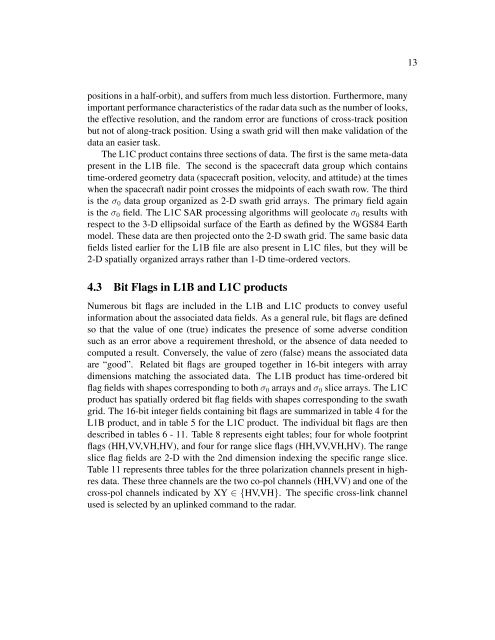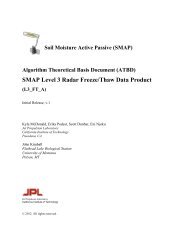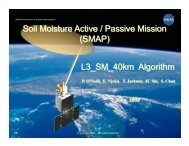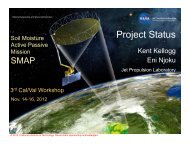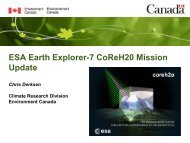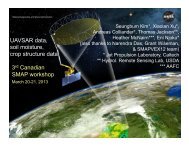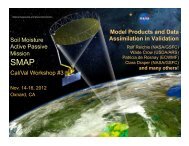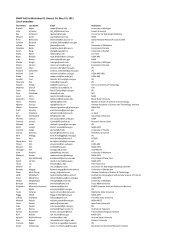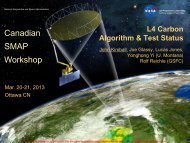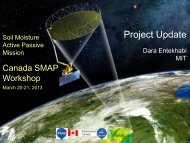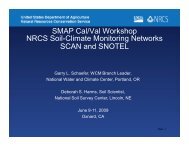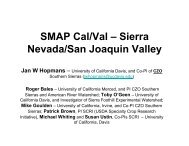(ATBD) SMAP Level 1 Radar Data Products - NASA
(ATBD) SMAP Level 1 Radar Data Products - NASA
(ATBD) SMAP Level 1 Radar Data Products - NASA
You also want an ePaper? Increase the reach of your titles
YUMPU automatically turns print PDFs into web optimized ePapers that Google loves.
13<br />
positions in a half-orbit), and suffers from much less distortion. Furthermore, many<br />
important performance characteristics of the radar data such as the number of looks,<br />
the effective resolution, and the random error are functions of cross-track position<br />
but not of along-track position. Using a swath grid will then make validation of the<br />
data an easier task.<br />
The L1C product contains three sections of data. The first is the same meta-data<br />
present in the L1B file. The second is the spacecraft data group which contains<br />
time-ordered geometry data (spacecraft position, velocity, and attitude) at the times<br />
when the spacecraft nadir point crosses the midpoints of each swath row. The third<br />
is the σ 0 data group organized as 2-D swath grid arrays. The primary field again<br />
is the σ 0 field. The L1C SAR processing algorithms will geolocate σ 0 results with<br />
respect to the 3-D ellipsoidal surface of the Earth as defined by the WGS84 Earth<br />
model. These data are then projected onto the 2-D swath grid. The same basic data<br />
fields listed earlier for the L1B file are also present in L1C files, but they will be<br />
2-D spatially organized arrays rather than 1-D time-ordered vectors.<br />
4.3 Bit Flags in L1B and L1C products<br />
Numerous bit flags are included in the L1B and L1C products to convey useful<br />
information about the associated data fields. As a general rule, bit flags are defined<br />
so that the value of one (true) indicates the presence of some adverse condition<br />
such as an error above a requirement threshold, or the absence of data needed to<br />
computed a result. Conversely, the value of zero (false) means the associated data<br />
are “good”. Related bit flags are grouped together in 16-bit integers with array<br />
dimensions matching the associated data. The L1B product has time-ordered bit<br />
flag fields with shapes corresponding to both σ 0 arrays and σ 0 slice arrays. The L1C<br />
product has spatially ordered bit flag fields with shapes corresponding to the swath<br />
grid. The 16-bit integer fields containing bit flags are summarized in table 4 for the<br />
L1B product, and in table 5 for the L1C product. The individual bit flags are then<br />
described in tables 6 - 11. Table 8 represents eight tables; four for whole footprint<br />
flags (HH,VV,VH,HV), and four for range slice flags (HH,VV,VH,HV). The range<br />
slice flag fields are 2-D with the 2nd dimension indexing the specific range slice.<br />
Table 11 represents three tables for the three polarization channels present in highres<br />
data. These three channels are the two co-pol channels (HH,VV) and one of the<br />
cross-pol channels indicated by XY ∈ {HV,VH}. The specific cross-link channel<br />
used is selected by an uplinked command to the radar.


